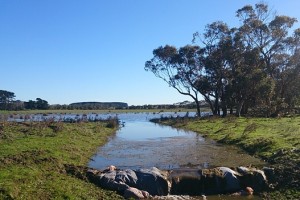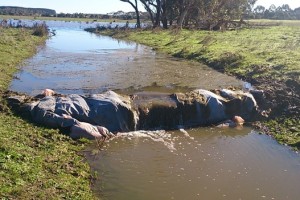This project involved the installation of a temporary sandbag weir in an artificial drain on a private property near Portland, in far south-western Victoria. The temporary weir was constructed using sandbags made from geo-textile material placed to form a weir wall and overflow sill within the existing drainage channel. The trial sandbag structure is designed to function as a drainage regulation weir, where water flowing out of the drainage channel is retained to promote pooling of the backwater into the natural wetland depression located directly upstream. In this instance, the landholder was interested in restoring the natural wetland area – noting that this area had become much drier since the construction of the drain – as the wetland area itself was considered to be of marginal value for agricultural purposes.
The temporary sandbag weir was installed in early June, prior to the above average July rains in that district, being completed by the landholder, members from a local landcare group and Nature Glenelg Trust. The weir structure has been designed to recreate a 4 hectare wetland area by restricting drainage outflows by up to 60 cm within the existing drainage channel. NGT’s Lachlan Farrington put together a short summary of the action, which can be viewed below:
Temporary trial weir structures provide both Nature Glenelg Trust and the landholders we work with, with an inexpensive and low risk approach to trialing wetland restoration measures. Once the functionality of the structure and its wetland restoration impact have been assessed by both parties – under real conditions – a permanent structure can be designed and installed according to a set of agreed criteria. In this way, trial structures can provide a valuable (no-obligation) first step, along the path to providing lasting, self-sustaining and effective wetland restoration solutions in the region.
Trial structures are not necessary at every site, but are a good option for people who are tentative about making the leap to a permanent structure, without having the opportunity to see what the potential inundation effect will be first under a range of settings and conditions. If you are interested in having a wetland restoration trial undertaken on your property, please contact us here.
This Case Study is the fourth in a series to illustrate wetland restoration in practice, delivered through Nature Glenelg Trust’s Wetland Restoration Program on Private Land and funded by the Australian Government.
- Exciting news! – A major expansion of the Walker Swamp Restoration Reserve is happening this June 24/06/2024
In some incredibly exciting news, I am delighted to announce that Nature Glenelg Trust has just been awarded a $595,000 grant from the Victorian Government, through the Nature Fund Program.
This incredibly timely announcement is the final piece of a $1.19M funding ‘puzzle’ that has now been fully assembled. This funding is enabling NGT to expand ...
- Final update on NGT’s priorities before the end of June – See what a donation to NGT could support this year 24/06/2024
With the end of financial year just around the corner, if you have been thinking of providing a donation to NGT before tax time this year, please take a look at our main current priorities below.
The land purchase at Walker Swamp this June is a great example of the type of restoration project ...
- Reflecting on World Environment Day 2024 – and thinking ‘big’ in land restoration 24/06/2024
On the 5th of June, which marks World Environment Day each year, we received the fantastic news that NGT’s project to expand our reserve at Walker Swamp – to include a large woodland restoration component – was funded by the Victorian Government’s Nature Fund Program. The timing of the announcement seems especially fitting, given that ...
- The Community Nursery is overflowing – So we’re having a July sale! 24/06/2024
Our Community Nursery is overflowing with plants, and it’s driving our Nursery Coordinator Ange a little crazy. So we’ve decided to have a quick plant sale in July!
With the lack of rain we haven’t been able to plant out some of our project areas and there’s no room in the nursery to start next years ...
- Healing a critically endangered swamp – Hesperilla Conservation Park one year later 24/06/2024
Back in late March 2023, following a prescribed burn, NGT oversaw earthworks at Hesperilla Conservation Park, a reserve that protects an important remnant of the critically endangered Fleurieu Peninsula Swamp ecological community. The earthworks backfilled several drains that were drawing groundwater out of the swamp and dehydrating the upper level of the peat that underlies ...
- Natives are good in gardens too – NGT awarded grant to spread the word about native plants in Mt Gambier 24/06/2024
We are excited to announce that we have been awarded a grant to promote the use of indigenous plant species in public gardens around Mount Gambier! The project aims to encourage the community to include native plants in their own gardens, by creating demonstration native gardens around Mt Gambier to showcase our beautiful native species. ...
- Wannon River Insights Part 4 – Long-term study of freshwater fish of the upper Wannon River 24/06/2024
Over the past three years, as part of an investigation into the ecology and hydrology of the Wannon River, whose catchment begins in the Grampians National Park in Victoria, we’ve had the opportunity to really grow our understanding around freshwater fish distribution and movement in the upper Wannon. Our initial understandings stem from work which ...
- Benefits of camera monitoring – another exciting observation at Eaglehawk Waterhole! 24/06/2024
Camera Monitoring (capturing footage and images using fixed point cameras) can be a time-consuming, data-hungry technique, requiring many hours of review and verification; identifying the subject matter is not always easy either. However, as the following video shows, it can reveal some unexpected species sightings!
Andy Lines, our awesome volunteer at Eaglehawk Waterhole, has recently started ...
- Latest Orange-bellied Parrot Sightings, and new OBP website 24/06/2024
A few things have been happening in the world of the Orange-bellied Parrots (OBP) over the last couple of months.
Every year, three count weekends are held where volunteers survey for OBP throughout their range, from SA’s Murray Mouth to Gippsland in Victoria, at the same time. The May count weekend recorded no sightings of OBP ...
- That’s a wrap – Annual Mount Lofty Ranges fish monitoring complete 24/06/2024
The annual Mount Lofty Ranges fish and habitat monitoring has been completed by NGT staff, revealing great ongoing data and trends in native and alien fish populations throughout the region. Monitoring in 2024 represents more than twenty years of data which is an amazing accomplishment. The work, funded by the Hills and Fleurieu, Murraylands and ...
Click here for the full list of project related blogs




Sorry, the comment form is closed at this time.